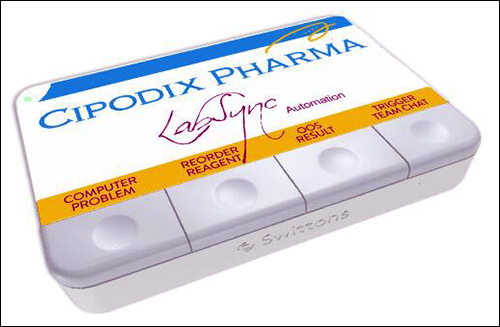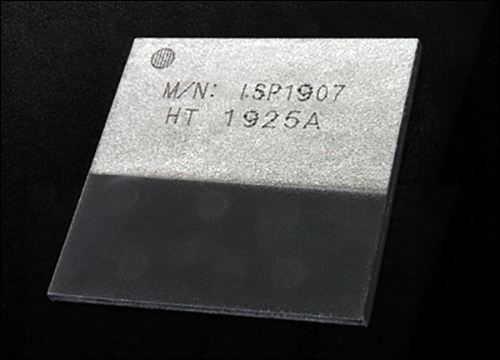Presented here are recent news announcements regarding the following organizations: P360, Swittons, Insight SiP, STMicroelectronics, NXP Semicondutors, the Auburn University RFID Lab, Paragon ID, Rockwell Automation and Microsoft.
P360 Upgrades Swittons IoT Smart Devices for Life Sciences
P360 has announced that its Swittons Internet of Things (IoT)-powered smart devices now feature expanded enterprise-level capabilities for life-sciences companies. The platform can be utilized across several functions within the same organization, the company reports, with workstream-specific customizations for each functional vertical. For example, it can be used to automate processes between pharmaceutical labs, supply chains and sales teams.
“Unlike multichannel solutions, which operate in silos by nature, omnichannel platforms like Swittons deliver a consistent, personalized user experience across all channels,” said Anupam Nandwana, P360’s CEO and founder, in a prepared statement. “Coupled with Microsoft foundational software elements, which provide seamless integrations across various user groups, the new Swittons package provides an advanced enterprise solution for sophisticated companies with multiplexed needs.”

The primary drivers of the Swittons omnichannel platform are life sciences digital innovation initiatives, the post-COVID-19 business environment, and constrictive regulatory matters regarding direct physician-to-pharma communication. The original Swittons design was focused on pharmaceutical commercial settings, the firm explains, whereas the smart devices help to streamline remote physician engagement by automating frequent requests and triggering communication channels. According to P360, the expansion into omnichannel enterprise applications has garnered interest from various pharmaceutical companies for several use cases.
With Pharma Labs, Swittons connects scientists and e-systems by automating functions such as opening tickets in service software (ServiceNow, Saleforce Service Cloud and Microsoft Dynamics), activating emergency alerts, automating reagent reorders, and triggering team messaging (emails and texts), as well as phone and video calls. With Pharma Supply Chains, Swittons serves as a connecting point to allow for remote communication, instant notifications and the restocking of various warehouses or pharmacy distribution centers at the click of a button. And with Clinical Trials, Swittons can be situated at clinical sites to enable one-touch requests of drug supplies or incidentals, or to trigger discussions with clinical research associates.
These use cases can be integrated with organization-wide analytics and AI, the company reports, helping users assimilate relevant data to the C-suite, while enabling a top-down, multi-tiered workstream of automations to occur within existing enterprise software solutions. This omnichannel approach to software integration allows for direct, human-to-digital information flow across previously siloed systems.
Each Swittons device can be custom-branded and programmed to align with specific workstreams and can be integrated with existing IT systems and enterprise platforms, such as enterprise resource planning, customer relationship management, enterprise asset management, clinical trial management, product lifecycle management and more. The devices can trigger phone and video calls via a built-in integration with Microsoft Teams and other virtual communication platforms. They are built on Microsoft Azure and automatically connect via a Wi-Fi or GSM cellular connection. The platform features a flexible user portal that includes device-usage dashboards and customizable analytics built on a Microsoft PowerBI foundation.
Insight SiP Launches BLE Module for Smart Lighting, Buildings
Insight SIP has announced the launch of its ISP1907-HT RF module, which features an extended temperature range and, according to the company, is suitable for smart-lighting and smart-building applications. The system includes Bluetooth Mesh, Zigbee and Thread protocols to enable multimode networks. It supports BLE direction finding and its microprocessor allows for its use with direction-finding anchor systems. The module can run sophisticated applications, the company reports, and be used with a range of Internet of Things (IoT) use cases.
Measuring 8 millimeters by 8 millimeters by 1 millimeter (0.3 inch by 0.3 inch by 0.04 inch), the module comes with an integrated antenna and features a long battery life, according to the company. This device, based on Nordic Semiconductor‘s nRF52833 2.4 GHz wireless system-on-chip (SoC), includes a 2.4 GHz transceiver, a 32-bit Arm Cortex-M4 processor, 512 kB of flash memory and 128 kB of SRAM, along with various analog and digital peripherals.

The ISP1907-HT supports multiple protocols, including BLE, ANT/ANT+, Thread and Zigbee, along with such proprietary 2.4 GHz protocols as Nordic Semiconductor’s Gazell. A range of stacks are available to support these protocols and can be downloaded for free. These include stacks for the nRF52833 SoC, such as the S113/S122/S140 SoftDevices, and others to run under the Zephyr real-time operating system. The ISP1907-HT comes with an embedded 32 MHz radio, 32 kHz synchronisation crystals, integrated RF-matching, and an antenna and DC-DC convertor.
Interfaces are supplied for analog or digital peripherals, including 30 GPIOs with 8 ADCs; an analog-to-digital convertor; SPI, PDM I2C and UART buses; and a USB peripheral interface. The system also provides pin compatibility with the ISP15, 18 and 19 series. “The new ISP1907-HT is ideal for customers looking for an ultra-miniature RF module to support applications requiring extended temperature range operations, long range and mesh networking,” said Nick Wood, Insight SiP’s sales and marketing director, in a prepared statement. “With its all-round capabilities and rich interface set, it is also well-suited to a wide range of other advanced IOT use cases.”
The module can run on a coin cell battery if required, which can last for up to several years, the company reports. Module prototypes are available now, and mass production of the modules is expected to begin during the first quarter of next year, with certification pending. To help product developers get started, Insight SiP offers a development kit and sample software.
STMicroelectronics Offers New BLE System-on-Chip
STMicroelectronics has unveiled its latest BlueNRG-LP Bluetooth LE system-on-chip (SoC), which leverages the latest Bluetooth features to increase communication range, raise throughput, strengthen security and save power. According to the company, the ultra-low-power radio consumes 3.4mA in receive mode, 4.3mA when transmitting and less than 500nA while awaiting wake-up events, cutting by half the battery size required for most applications, while prolonging runtime.
BlueNRG-LP, ST’s third-generation Bluetooth SoC, is Bluetooth LE 5.2-certified and supports concurrent connections with up to 128 nodes, enabling low-latency control and the monitoring of large numbers of connected devices, such as from a smartphone app. It features high RF-output power programmable up to +8dBm, as well as RF sensitivity up to -104dBm, and can natively cover a large area in beacon, smart-lighting, gaming, building-automation, industrial and tracking applications.
According to the company, the communication range can be extended without limit by adding BLE Mesh, fully certified and available as part of the BlueNRG software and hardware ecosystem. In addition, BlueNRG-LP supports Bluetooth Long Range mode, which uses coded physical layers with forward error connection to extend radio-communication range up to hundreds of meters and increase reliability, while utilizing GATT caching to connect quickly and efficiently.
The BlueNRG-LP comes with ST’s BLE protocol stack, certified to Core Specification 5.2 and designed to match its power architecture. The stack—a free, compiler-independent linkable library supported by multiple integrated development environments—offers a small footprint, modularity, low latency, interoperability and lifetime over-the-air upgradability. It supports such features as extended advertising and scanning, high-duty-cycle non-connectable advertising, extended packet length, and throughput of 2 megabytes per second. In addition, the SoC supports L2CAP Connection-Oriented Channel, which eases large bidirectional data transfers, multi-role simultaneous connectivity and Channel Selection Algorithm #2 (CSA #2), to permit connections in noisy environments such as home, building or industrial networks.
Security mechanisms included in the integrated Arm Cortex-M0+ microcontroller comprise a secure bootloader, readout protection for the entire 256 KB of embedded flash, a 48-bit unique ID, customer key storage, a random-number generator, a hardware public-key accelerator and a 128-bit AES cryptographic co-processor. The processing unit executes code at up to 64 MHz, consumes 18µA/MHz and features industry-standard digital interfaces, a multi-channel 12-bit ADC, an analog microphone interface with a programmable gain amplifier, user and system timers and watchdog, and up to 31 5-volt-tolerant user-programmable I/O pins.
The BlueNRG-LP SoC integrates an embedded RF balun, a DC/DC converter, and capacitors for the high-speed external oscillator and internal low-speed ring oscillator. The device is available in a choice of wafer-level package sizes: 5-millimeter by 5-millimeter (QFN32), 6-millimeter by 6-millimeter (QFN48) and 3.14-millimeter by 3.14-millimeter (WLCSP49). It features 32 KB or 64 KB RAM and a choice of temperature ranges up to 85 degrees or 105 degrees Celsius (85 degrees or 221 degrees Fahrenheit). The SoCs are in production now.
NXP Unveils BLE Solutions for IoT, Gaming and More
NXP Semiconductors has announced its 2×2 family of Wi-Fi 6 (802.11ax) Dual Band + Bluetooth/BLE solutions for the Internet of Things (IoT), gaming, audio and industrial markets. With its Wi-Fi 6-enabled gaming console, NXP’s IW62X products are designed to increase capacity, efficiency and performance for connectivity solutions, the company explains, including smart consumer IoT hubs, wireless speakers, video-enabled smart devices, augmented and virtual reality devices, and additional IoT applications.
The 2×2 Wi-Fi 6 solutions are suitable for gaming consoles requiring high-performance Wi-Fi with near-zero wireless controller lag time and low-latency multiplayer gaming experiences via a single, in-room console over wireless networks. The solutions offer real-time interactions for cloud-based gaming devices, clients and services by providing high-bandwidth and low-latency connectivity for 4k/60 fps gameplay.

“This product announcement reinforces NXP’s position at the cutting edge of connectivity and our ability to enable advanced wireless capabilities for the future of gaming plus the exponential growth in Wi-Fi 6 access points and IoT devices tethered to a single gateway,” said Rafael Sotomayor, NXP’s executive VP of connectivity and security, in a prepared statement. “Our IW62X family of integrated Wi-Fi 6 + Bluetooth solutions brings a step-change in high performance and power efficient solutions for the latest-generation of smart home IoT services, connected industrial applications and the vast number of consumer devices that rely on power-efficient Wi-Fi and Bluetooth connectivity to maximize the user experience.”
The BT/BLE radios support Bluetooth/BLE standards (BLE LR/2Mbps, BLE AoA/AoD, BLE Mesh), independent Bluetooth connections and operational modes with multiple external devices. This enables smart-hub and smart-home services that use Bluetooth-based positioning and mesh connectivity, providing support for numerous applications, including dual or independent wireless headset support, as well as for audio steaming via stereo A2DP and isochronous channel. The system allows separate low-power peripheral or accessory control, including speaker, voice assistant, audio hubs or soundbar, physical remote control and low-power device wakeup.
The IW62X family features 2.4 and 5 GHz dual-band power amplifiers, low-noise amplifier antenna switches, and a power-management unit built to reduce system-level bill of materials and device board area, while simplifying chip-on-board and integrated-module designs. The solutions are available for sampling now and are expected to soon be offered by select partners.
Auburn University RFID Lab Certifies Paragon ID Tags, Inlays
Paragon ID has announced that it has secured the Auburn University RFID Lab‘s ARC Quality Certification for the design, manufacturing and supply of its RFID inlays and tags. This QMS Certification signifies the quality, reliability and performance of Paragon ID’s RFID inlay products for its customers and partners across the UHF RFID ecosystem, the company reports.
The Auburn RFID Lab is globally recognized for its independent certification of RFID inlays and tags, and this certification indicates Paragon ID’s manufacturing expertise, resources and capabilities cover all critical aspects of RFID inlay design and production. As the adoption of RFID technology accelerates, particularly in retail and other sectors, such as aviation, the ARC Quality program ensures that the tags offered are certified for purpose and perform reliably to best fit end users’ needs.
“Paragon ID is honored to receive this certification from ARC,” said Clem Garvey, the company’s CEO, in a prepared statement. “This is a milestone in Paragon ID’s journey to become one of the highest-quality manufacturers in the RFID industry. Over the last eight months, the world has become a different place and the changes we are seeing today will inevitably accelerate the adoption of new technologies and their associated new solutions.”
Garvey added, “Internet of Things solutions will crystalize from an aspiration to a reality. Paragon ID is very proud to be able to play a role in that crystallization, and in promoting RFID as the key technology at its heart. We look forward to continuing to work with ARC in this endeavor.”
Rockwell Automation, Microsoft Expand IIoT Partnership
Rockwell Automation and Microsoft have announced a five-year partnership expansion to develop integrated solutions designed to help industrial customers improve their digital agility via cloud technology. The companies’ experience in the industrial and IT markets enables teams to work together more seamlessly, the partners report, enabling industrial organizations to lower infrastructure costs and increase productivity. Organizations can access Rockwell Automation’s solutions via the Microsoft Azure marketplace now, and more solutions are currently in development.
Microsoft and Rockwell Automation are partnering to provide edge-to-cloud-based solutions that connect information between development, operations and maintenance teams via a single trusted data environment. This will allow development teams to digitally prototype, configure and collaborate without having to invest in expensive equipment, the companies explain. This unified information environment also enables IT and OT teams to securely access and share data models across an organization and with partners.
“Today, one thing we know for sure is that no business is 100 percent resilient. Those fortified with digital capabilities and assets are more resilient than others, and the cloud is how they will thrive,” said Judson Althoff, Microsoft’s executive VP of worldwide commercial business, in a prepared statement. “We are pleased to deepen our already strong, decade-long relationship with Rockwell Automation to help businesses simplify industrial transformation, accelerate business outcomes and innovate with agility.” The two companies have co-developed more than 20 use cases to date in the food and beverage, household and personal care, and life-sciences industries.
“This partnership provides Rockwell Automation and Microsoft customers with a holistic, simple solution for IIoT development and operations and removes data silos that hinder industrial digital transformation initiatives,” added Blake Moret, Rockwell Automation’s chairman and CEO, in the prepared statement. “By eliminating a core barrier to automation initiatives, industrial organizations establish a digital thread connecting the entire enterprise, which in turn accelerates innovation, maximizes productivity and optimizes operations.”


